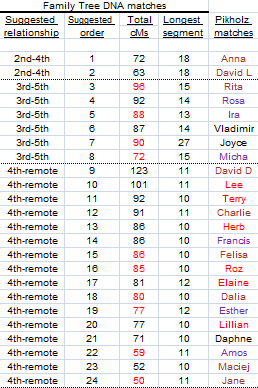Like the turning of the calendar year.
Traveling and speaking
I have never traveled abroad as much as in the past year. Three trips, nine weeks, twenty-four presentations (plus one more that was snowed out), even two television interviews. Lots of family visits, including with close relatives I hadn't seen in many years.
But enough about last year. Next year is upon us and although some potential speaking venues say "talk to us later," more say "talk to us about 2018, as we are already booked." I cannot think that far ahead.
I am giving one presentation at RootsTech in Salt Lake City, and like last year I'd like to set up a few events before and after. Mostly before, because of the timing. Three dates are nailed down, with a few others under discussion and (ATTENTION PROGRAM CHAIRS!) the schedule looks like this.
22 January (Sunday) - JGS of Maryland
29 January (Sunday) - JGS of Philadelphia
10 February (Friday) - RootsTech
- The days between Baltimore and Philadelphia are available for the east coast.
- The days following Philadelphia are available for most anywhere.
- I want to use the days leading up to RootsTech for research in Salt Lake City.
- Notable are the Sundays on either end of RootsTech, which are still available.
I am certainly not limiting myself to my basic genetic genealogy presentation "Lessons in Jewish DNA - One Man's Successes and What He Learned on the Journey." That's what is scheduled for Philadelphia and RootsTech, but there will be something new in Baltimore. "GEDmatch.com’s Lazarus Tool As It Applies to Two Kinds of Endogamy" which I unveiled in Seattle is also a possibility, as are some other topics.
Invitations from non-Jewish groups are most welcome.
 |
| Nana's mother's side, the Bauers and the Sterns |
As it happens, a few days ago someone who heard me speak in northern Israel last year told me about a friend of hers in Prague who is a Zelinka relative of mine and talking to her should help us with the Slovakian portion of our trip. The one here speaks to me in Hebrew and to the woman in Prague in Czech. I wrote to the Prague cousin in English and she replied in a sort of Hebrew in Latin letters with a Czech "accent." Of course, conversation with Linda and Cyndi is strictly English, though Linda can manage basic Hebrew. Karesz speaks everything.
(The places in red on these maps are where Nana's ancestors lived.)
 |
| Nana's father's side, the Rosenzweigs and the Zelinkas |
Little Sister
There is a prayer called "Little Sister," written 7-800 years ago, which opens the New Year service - this year, Sunday evening. More precisely, although it is printed in most versions of the service, most Ashkenazic congregations don't say it, while the Sepharadim sing it in unison.
But we all know the takeaway lines.
Seven of the eight verses end with the line "The year will end and with it, its curses." The eighth concludes "Let the year and its blessings begin." Often, we put those two phrases together as a blessing for the New Year.
We exit a year that we all experienced together and enter a year where we each have our own hopes and dreams.
May you and your families be written and sealed in the Book of Life.







